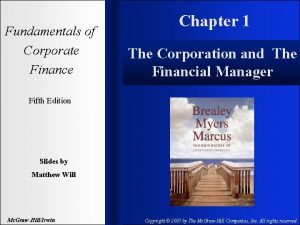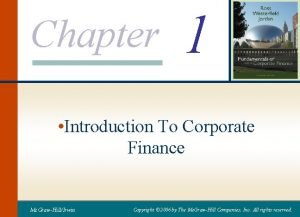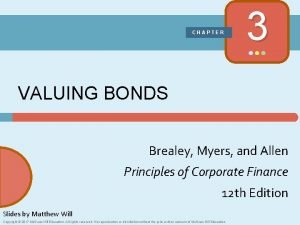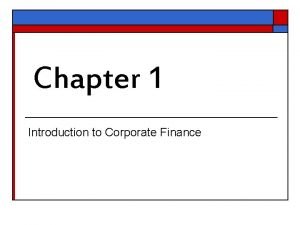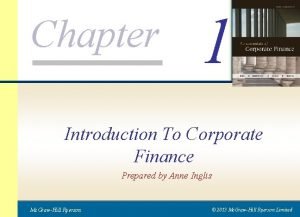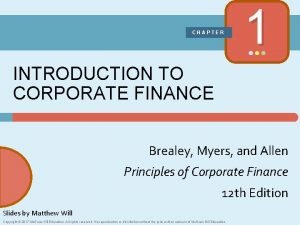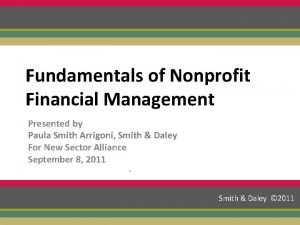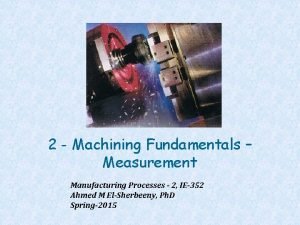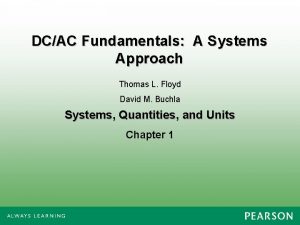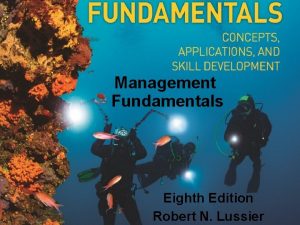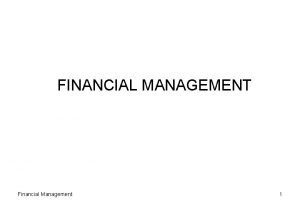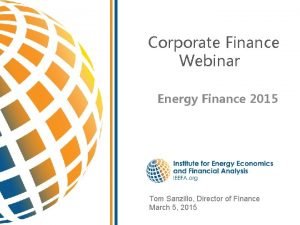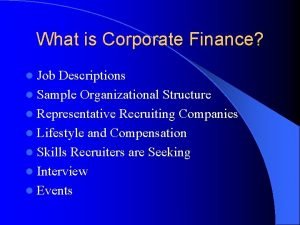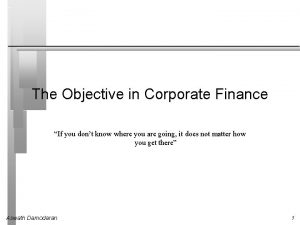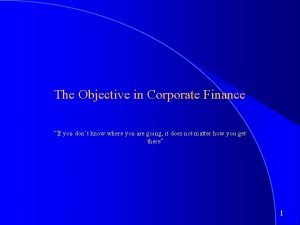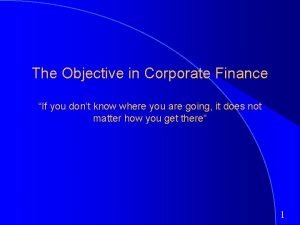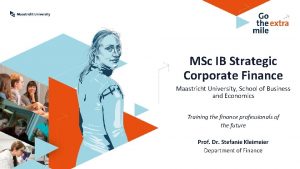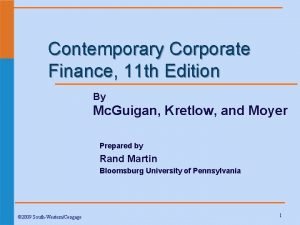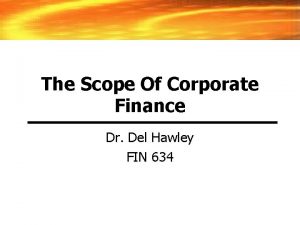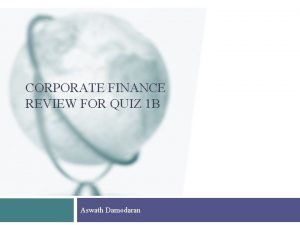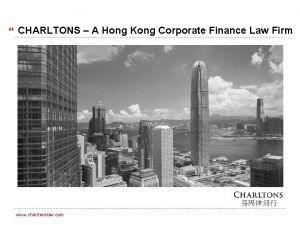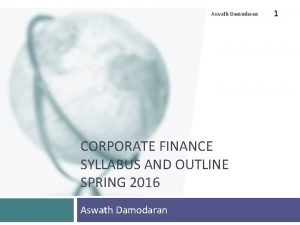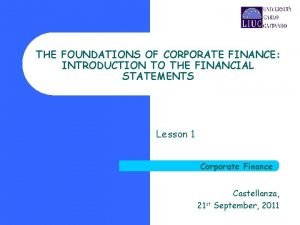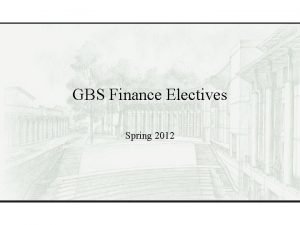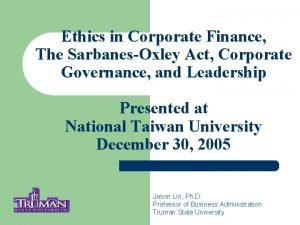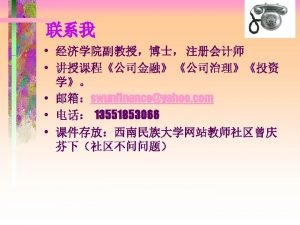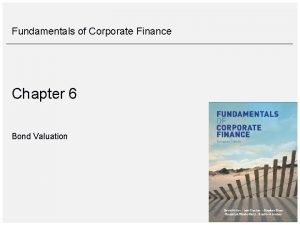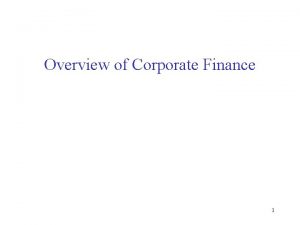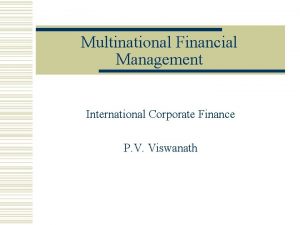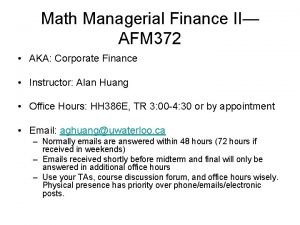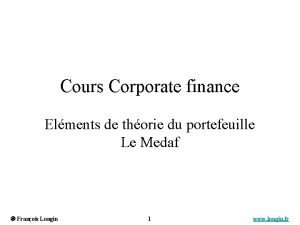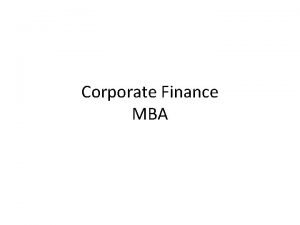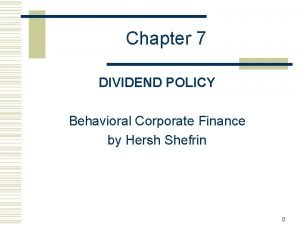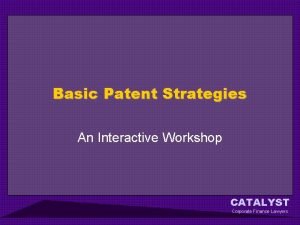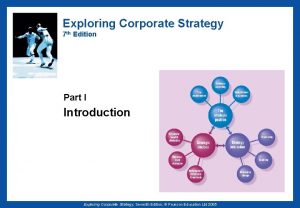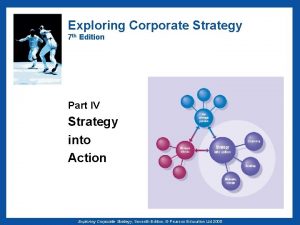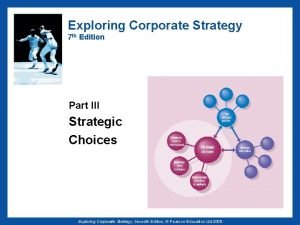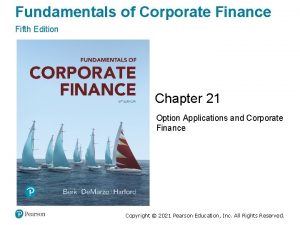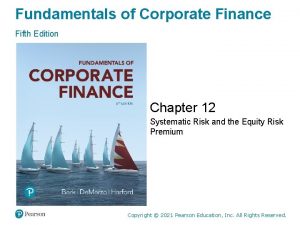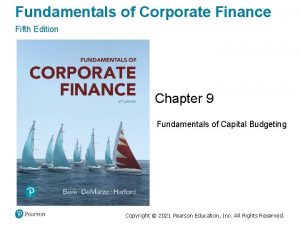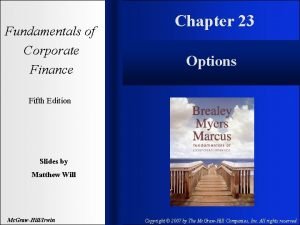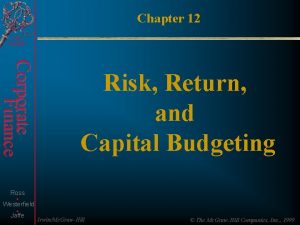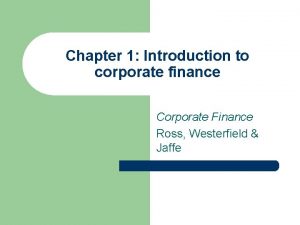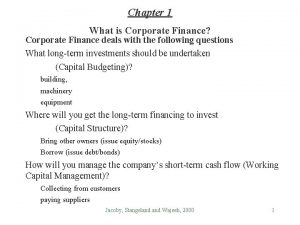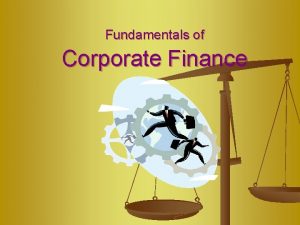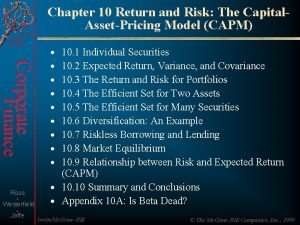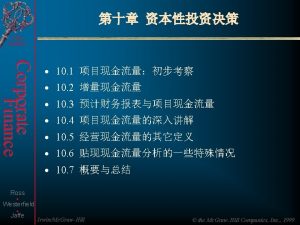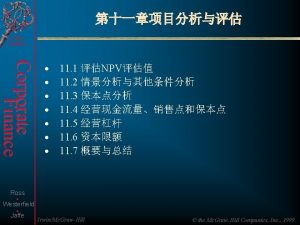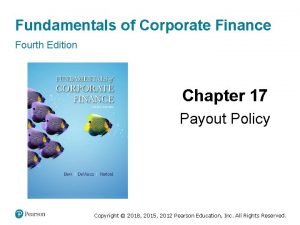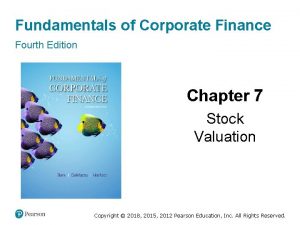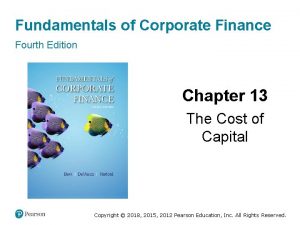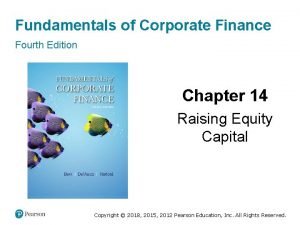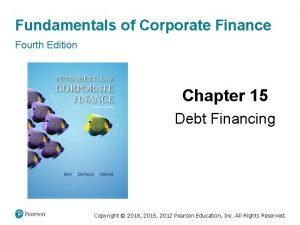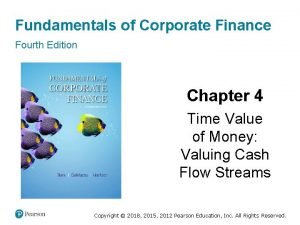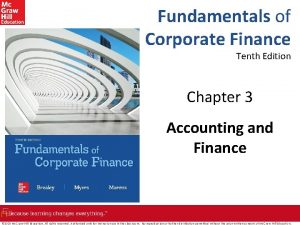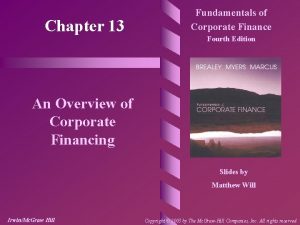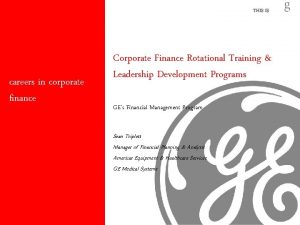Fundamentals of Corporate Finance Fifth Edition Chapter 13












































































- Slides: 76

Fundamentals of Corporate Finance Fifth Edition Chapter 13 The Cost of Capital Slide in this Presentation Contain Hyperlinks. JAWS users should be able to get a list of links by using INSERT+F 7 Copyright © 2021 Pearson Education, Inc. All Rights Reserved.

Chapter Outline 13. 1 A First Look at the Weighted Average Cost of Capital 13. 2 The Firm’s Costs of Debt and Equity Capital 13. 3 A Second Look at the Weighted Average Cost of Capital 13. 4 Using the W A C C to Value a Project 13. 5 Project-Based Costs of Capital 13. 6 When Raising External Capital Is Costly Copyright © 2021 Pearson Education, Inc. All Rights Reserved.

Learning Objectives (1 of 2) • Understand the drivers of the firm’s overall cost of capital • Measure the costs of debt, preferred stock, and common stock • Compute a firm’s overall, or weighted average, cost of capital Copyright © 2021 Pearson Education, Inc. All Rights Reserved.

Learning Objectives (2 of 2) • Apply the weighted average cost of capital to value projects • Adjust the cost of capital for the risk associated with the project • Account for the direct costs of raising external capital Copyright © 2021 Pearson Education, Inc. All Rights Reserved.

13. 1 A First Look at the Weighted Average Cost of Capital (1 of 5) • The Firm’s Capital Structure – Capital Structure Copyright © 2021 Pearson Education, Inc. All Rights Reserved.

Figure 13. 1 A Basic Balance Sheet Assets Liabilities and Equity Current Assets Debt Long-Term Assets Preferred Stock Blank Equity Copyright © 2021 Pearson Education, Inc. All Rights Reserved.

Figure 13. 2 Two Capital Structures Source: Authors’ calculations based on publicly available data in 2019. Percentages are based on market value of equity. Copyright © 2021 Pearson Education, Inc. All Rights Reserved.

13. 1 A First Look at the Weighted Average Cost of Capital (2 of 5) • Opportunity Cost and the Overall Cost of Capital • Weighted Averages and the Overall Cost of Capital – Weighted Average Cost of Capital (W A C C) – Market-Value Balance Sheet Market Value of Equity + Market Value of Debt = Market (Eq. 13. 1) Value of Assets Copyright © 2021 Pearson Education, Inc. All Rights Reserved.

13. 1 A First Look at the Weighted Average Cost of Capital (3 of 5) • Weighted Average Cost of Capital Calculations – Leverage § Unlevered- Equity finance company § Levered- Mix of debt and equity Copyright © 2021 Pearson Education, Inc. All Rights Reserved.

13. 1 A First Look at the Weighted Average Cost of Capital (4 of 5) • Weighted Average Cost of Capital Calculations – The Weighted Average Cost of Capital: Unlevered Firm § r. W A C C = Equity Cost of Capital Copyright © 2021 Pearson Education, Inc. All Rights Reserved.

13. 1 A First Look at the Weighted Average Cost of Capital (5 of 5) • Weighted Average Cost of Capital Calculations – The Weighted Average Cost of Capital: Levered Firm (Eq. 13. 2) Copyright © 2021 Pearson Education, Inc. All Rights Reserved.

Example 13. 1 Calculating the Weights in the W A C C (1 of 4) Problem: • Suppose Kenai Corp. has debt with a book (face) value of $10 million, trading at 95% of face value. It also has book equity of $10 million, and 1 million shares of common stock trading at $30 per share. What weights should Kenai use in calculating its W A C C? Copyright © 2021 Pearson Education, Inc. All Rights Reserved.

Example 13. 1 Calculating the Weights in the W A C C (2 of 4) Solution: Plan: • Equation 13. 2 tells us that the weights are the fractions of Kenai financed with debt and financed with equity. • Furthermore, these weights should be based on market values because the cost of capital is based on investors’ current assessment of the value of the firm, not on accounting-based book values. Consequently, we can ignore the book values of debt and equity. Copyright © 2021 Pearson Education, Inc. All Rights Reserved.

Example 13. 1 Calculating the Weights in the W A C C (3 of 4) Execute: • $10 million in debt trading at 95% of face value is $9. 5 million in market value. One million shares of stock at $30 per share is $30 million in market value. So, the total market value of the firm is $39. 5 million. The weights are 9. 5/39. 5= 24. 1% debt and 30/39. 5 = 75. 9% for equity Copyright © 2021 Pearson Education, Inc. All Rights Reserved.

Example 13. 1 Calculating the Weights in the W A C C (4 of 4) Evaluate: • When calculating its overall cost of capital, Kenai will use a weighted average of the cost of its debt capital and the cost of its equity capital, giving a weight of 24. 1% to its cost of debt and a weight of 75. 9% to its cost of equity. Copyright © 2021 Pearson Education, Inc. All Rights Reserved.

13. 2 The Firm’s Costs of Debt and Equity Capital (1 of 7) • Cost of Debt Capital – Yield to Maturity and the Cost of Debt § The Yield to Maturity is the yield that bond purchasers would earn if they held the debt to maturity and received all the payments as promised § Can use it to estimate the firm's current cost of debt: the yield that investors demand to hold the firm’s debt (new or existing) – Taxes and the Cost of Debt § Effective Cost of Debt (Eq. 13. 3) where TC is the corporate tax rate. Copyright © 2021 Pearson Education, Inc. All Rights Reserved.

Example 13. 2 Effective Cost of Debt (1 of 4) Problem: • By using the yield to maturity on A T&T’s debt, we found that its pretax cost of debt is 3. 18%. If A T&T’s tax rate is 25%, what is its effective cost of debt? Copyright © 2021 Pearson Education, Inc. All Rights Reserved.

Example 13. 2 Effective Cost of Debt (2 of 4) Solution: Plan: • We can use Equation 13. 3 to calculate A T&T’s effective cost of debt: r. D = 0. 0318 (pretax cost of debt) TC = 0. 25 (corporate tax rate) AT&T’s effective cost of debt is 0. 0318 ( 1 – 0. 25) = 0. 02385 = 2. 385%. Copyright © 2021 Pearson Education, Inc. All Rights Reserved.

Example 13. 2 Effective Cost of Debt (4 of 4) Evaluate: • For every new $1000 it borrows, A T&T would pay its bondholders 0. 0318 ($1000) = $31. 80 in interest every year. Because it can deduct that $31. 80 in interest from its income, every dollar in interest saves A T&T 25 cents in taxes, so the interest tax deduction reduces the firm’s tax payment to the government by 0. 25 ($31. 80) = $7. 95. • Thus, A T&T’s net cost of $1000 of debt is the $31. 80 it pays minus the $7. 95 in reduced tax payments, which is $23. 85 per $1000 or 2. 385%. Copyright © 2021 Pearson Education, Inc. All Rights Reserved.

13. 2 The Firm’s Costs of Debt and Equity Capital (2 of 7) • Cost of Preferred Stock Capital (Eq. 3. 4) • Assume A T&T’s preferred stock has a price of $25. 43 and an annual dividend of $1. 37. Its cost of preferred stock, therefore, is Copyright © 2021 Pearson Education, Inc. All Rights Reserved.

13. 2 The Firm’s Costs of Debt and Equity Capital (3 of 7) • Cost of Common Stock Capital – Capital Asset Pricing Model § From Chapter 12 1. Estimate the firm’s beta of equity, typically by regressing 60 months of the company’s returns against 60 months of returns for a market proxy such as the S&P 500 2. Determine the risk-free rate, typically by using the yield on Treasury bills or bonds Copyright © 2021 Pearson Education, Inc. All Rights Reserved.

13. 2 The Firm’s Costs of Debt and Equity Capital (4 of 7) • Cost of Common Stock Capital – Capital Asset Pricing Model § From Chapter 12 3. Estimate the market risk premium, typically by comparing historical returns on a market proxy to contemporaneous risk-free rates 4. Apply the C A P M: Cost of Equity = Risk-Free Rate + Equity Beta × Market Risk Premium Copyright © 2021 Pearson Education, Inc. All Rights Reserved.

13. 2 The Firm’s Costs of Debt and Equity Capital (5 of 7) • Cost of Common Stock Capital – Capital Asset Pricing Model § Assume the equity beta of A T&T is 0. 6, the yield on ten-year Treasury notes is 3%, and you estimate the market risk premium to be 6%. A T&T’s cost of equity is 3% + 0. 60 × 6% = 6. 6% Copyright © 2021 Pearson Education, Inc. All Rights Reserved.

13. 2 The Firm’s Costs of Debt and Equity Capital (6 of 7) • Cost of Common Stock Capital – Constant Dividend Growth Model (Eq. 13. 5) Copyright © 2021 Pearson Education, Inc. All Rights Reserved.

13. 2 The Firm’s Costs of Debt and Equity Capital (7 of 7) • Cost of Common Stock Capital – Constant Dividend Growth Model § Assume in early-2019, the average forecast for A T&T’s long-run earnings growth rate was 2. 85%. With an expected dividend in one year of $2. 04 and a price of $32. 20, the C D G M estimates A T&T’s cost of equity as follows (using Equation 13. 5): Copyright © 2021 Pearson Education, Inc. All Rights Reserved.

Estimating the Cost of Equity Table 13. 1 Estimating the Cost of Equity Blank Capital Asset Pricing Model Constant Dividend Growth Model Inputs Equity beta Current stock price Blank Risk-free rate Expected dividend next year Blank Market risk premium Future dividend growth rate Major Assumptions Estimated beta is correct Dividend estimate is correct Blank Market risk premium is accurate Growth rate matches market expectations Blank CAPM is the correct model Future dividend growth is constant Copyright © 2021 Pearson Education, Inc. All Rights Reserved.

Example 13. 3 Estimating the Cost of Equity (1 of 8) Problem: • Assume the equity beta for Johnson & Johnson (ticker: J N J) is 0. 55. The yield on 10 -year treasuries is 3%, and you estimate the market risk premium to be 6%. Furthermore, Johnson & Johnson issues dividends at an annual rate of $2. 81. Its current stock price is $92. 00, and you expect dividends to increase at a constant rate of 4% per year. • Estimate J&J’s cost of equity in two ways. Copyright © 2021 Pearson Education, Inc. All Rights Reserved.

Example 13. 3 Estimating the Cost of Equity (2 of 8) Solution: Plan: • The two ways to estimate J&J’s cost of equity are to use the C A P M and the C D G M. 1. The C A P M requires the risk-free rate, an estimate of the equity’s beta, and an estimate of the market risk premium. We can use the yield on 10 -year Treasury notes as the risk-free rate. Copyright © 2021 Pearson Education, Inc. All Rights Reserved.

Example 13. 3 Estimating the Cost of Equity (3 of 8) Solution: Plan: • The two ways to estimate J&J’s cost of equity are to use the C A P M and the C D G M. 2. The C D G M requires the current stock price, the expected dividend next year, and an estimate of the constant future growth rate for the dividend. Copyright © 2021 Pearson Education, Inc. All Rights Reserved.

Example 13. 3 Estimating the Cost of Equity (4 of 8) Solution: Plan: • Risk-free rate: 3% Current price: $92. 00 • Equity beta: 0. 55 Expected dividend: $2. 81 • Market risk premium: 6% Estimated future dividend growth rate: 4% • We can use the C A P M from Chapter 12 to estimate the cost of equity using the C A P M approach and Equation 13. 5 to estimate it using the C D G M approach. Copyright © 2021 Pearson Education, Inc. All Rights Reserved.

Example 13. 3 Estimating the Cost of Equity (5 of 8) Execute: • The C A P M says that • The C D G M says that Copyright © 2021 Pearson Education, Inc. All Rights Reserved.

Example 13. 3 Estimating the Cost of Equity (6 of 8) Evaluate: • According to the C A P M, the cost of equity capital is 6. 3%; the C D G M produces a result of 7. 1%. Because of the different assumptions we make when using each method, the two methods do not have to produce the same answer —in fact, it would be highly unlikely that they would. • When the two approaches produce different answers, we must examine the assumptions we made for each approach and decide which set of assumptions is more realistic. Copyright © 2021 Pearson Education, Inc. All Rights Reserved.

Example 13. 3 Estimating the Cost of Equity (7 of 8) Evaluate: • We can also see what assumption about future dividend growth would be necessary to make the answers converge. By rearranging the C D G M and using the cost of equity we estimated from the C A P M, we have Copyright © 2021 Pearson Education, Inc. All Rights Reserved.

Example 13. 3 Estimating the Cost of Equity (8 of 8) Evaluate: • Thus, if we believe that J&J’s dividends will grow at a rate of 3. 2% per year, the two approaches would produce the same cost of equity estimate. Copyright © 2021 Pearson Education, Inc. All Rights Reserved.

13. 3 A Second Look at the Weighted Average Cost of Capital (1 of 5) • W A C C Equation rwacc = r. EE% + rpfd P% + r. D(1 TC) D% – For a company that does not have preferred stock, the W A C C condenses to: rwacc = r. EE% + r. D(1 TC) D% (Eq. 13. 7) Copyright © 2021 Pearson Education, Inc. All Rights Reserved.

13. 3 A Second Look at the Weighted Average Cost of Capital (2 of 5) • W A C C Equation – in 2019, the market values of A T&T’s common stock, preferred stock, and debt were $234, 560 million, $2, 185 million, and $176, 505 million, respectively. – Its total value was, therefore, $234, 560 million + $2, 185 million + $176, 505 million = $413, 250 million. – Given the costs of common stock (C A P M estimate), preferred stock, and debt we have already computed, A T&T’s W A C C (using Equation 13. 6) in 2019 was: Copyright © 2021 Pearson Education, Inc. All Rights Reserved.

13. 3 A Second Look at the Weighted Average Cost of Capital (3 of 5) • W A C C Equation Copyright © 2021 Pearson Education, Inc. All Rights Reserved.

Example 13. 4 Computing the WAC C (1 of 4) Problem: • Assume the expected return on Target’s equity is 11. 5%, and the firm has a yield to maturity on its debt of 6%. • Debt accounts for 18% and equity for 82% of Target’s total market value. • If its tax rate is 25%, what is an estimate of this firm’s W A C C? Copyright © 2021 Pearson Education, Inc. All Rights Reserved.

Example 13. 4 Computing the W A C C (2 of 4) Solution: Plan: • We can compute the W A C C using Equation 13. 7. To do so, we need to know the costs of equity and debt, their proportions in Target’s capital structure, and the firm’s tax rate. • We have all that information, so we are ready to proceed. Copyright © 2021 Pearson Education, Inc. All Rights Reserved.

Example 13. 4 Computing the WAC C (3 of 4) Execute: rwacc = r. EE% + r. D (1 − TC) D% = (0. 115)(0. 82) + (0. 06)(1 − 0. 25)(0. 18) = 0. 102 or 10. 2% Copyright © 2021 Pearson Education, Inc. All Rights Reserved.

Example 13. 4 Computing the WAC C (4 of 4) Evaluate: • Even though we cannot observe the expected return of Target’s investments directly, we can use the expected return on its equity and debt and the W A C C formula to estimate it, adjusting for the tax advantage of debt. • Target needs to earn at least a 10. 2% return on its investment in current and new stores to satisfy both its debt and equity holders. Copyright © 2021 Pearson Education, Inc. All Rights Reserved.

Figure 13. 3 W A C C s for Real Companies Source: Authors’ calculations based on publicly available information in 2019. Copyright © 2021 Pearson Education, Inc. All Rights Reserved.

13. 3 A Second Look at the Weighted Average Cost of Capital (4 of 5) • Methods in Practice – Net Debt § Net Debt = Debt − Cash and Risk-Free Securities (Eq. 13. 8) Copyright © 2021 Pearson Education, Inc. All Rights Reserved.

13. 3 A Second Look at the Weighted Average Cost of Capital (5 of 5) • Methods in Practice – The Risk-Free Interest Rate § Most firms use the yields on long-term treasury bonds – The Market-Risk Premium § Since 1926, the S&P 500 has produced an average return of 7. 7% above the rate for one-year Treasury securities § Since 1962, the S&P 500 has shown an excess return of only 5. 5% over the rate for one-year Treasury securities Copyright © 2021 Pearson Education, Inc. All Rights Reserved.

Historical Excess Returns of the S&P 500 Compared to One-Year Treasury Bills and Ten. Year U. S. Treasury Securities Table 13. 2 Historical Excess Returns of the S&P 500 Compared to One-Year Treasury Bills and Ten-Year U. S. Treasury Securities S&P 500 Excess Return Versus Period 1926– 2015 Period 1965 -2015 One-year Treasury 7. 7% 5. 0% 10 -year Treasury* 5. 9% 3. 9% *Based on a comparison of compounded returns over a 10 -year holding period. Copyright © 2021 Pearson Education, Inc. All Rights Reserved.

13. 4 Using the W A C C to Value a Project (1 of 9) • Levered Value – The value of an investment, including the benefit of the interest tax deduction, given the firm’s leverage policy • W A C C Valuation Method – Discounting future incremental free cash flows using the firm’s W A C C, which produces the levered value of a project Copyright © 2021 Pearson Education, Inc. All Rights Reserved.

13. 4 Using the W A C C to Value a Project (2 of 9) • Levered Value (Eq. 13. 9) Copyright © 2021 Pearson Education, Inc. All Rights Reserved.

Example 13. 5 The W A C C Method (1 of 4) Problem: • Suppose Anheuser-Busch In. Bev is considering introducing a new ultra-light beer with zero calories to be called Bud. Zero. The firm believes that the beer’s flavor and appeal to calorie-conscious drinkers will make it a success. • The cost of bringing the beer to market is $200 million, but Anheuser-Busch In. Bev expects firstyear incremental free cash flows from Bud. Zero to be $100 million and to grow at 3% per year thereafter. • If Anheuser-Busch In. Bev’s W A C C is 5. 7%, should it go ahead with the project? Copyright © 2021 Pearson Education, Inc. All Rights Reserved.

Example 13. 5 The W A C C Method (2 of 4) Solution: Plan: • We can use the W A C C method shown in Eq. 13. 9 to value Bud. Zero and then subtract the up-front cost of $200 million. We will need Anheuser-Busch In. Bev’s W A C C, which is 5. 7%. Copyright © 2021 Pearson Education, Inc. All Rights Reserved.

Example 13. 5 The W A C C Method (3 of 4) Execute: • The cash flows for Bud. Zero are a growing perpetuity. Applying the growing perpetuity formula with the W A C C method, we have Copyright © 2021 Pearson Education, Inc. All Rights Reserved.

Example 13. 5 The W A C C Method (4 of 4) Evaluate: • The Bud. Zero project has a positive N P V because it is expected to generate a return on the $200 million far in excess of Anheuser-Busch In. Bev’s W A C C of 5. 7%. • As discussed in Chapter 8, taking positive-N P V projects adds value to the firm. • Here, we can see that the value is created by exceeding the required return of the firm’s investors. Copyright © 2021 Pearson Education, Inc. All Rights Reserved.

13. 4 Using the W A C C to Value a Project (3 of 9) • Key Assumptions – Average Risk § We assume initially that the market risk of the project is equivalent to the average market risk of the firm’s investments – Constant Debt-Equity Ratio § We assume that the firm adjusts its leverage continuously to maintain a constant ratio of the market value of debt to the market value of equity Copyright © 2021 Pearson Education, Inc. All Rights Reserved.

13. 4 Using the W A C C to Value a Project (4 of 9) • Key Assumptions – Limited Leverage Effects § We assume initially that the main effect of leverage on valuation follows from the interest tax deduction and that any other factors are not significant at the level of debt chosen Copyright © 2021 Pearson Education, Inc. All Rights Reserved.

13. 4 Using the W A C C to Value a Project (5 of 9) • Key Assumptions – Assumptions in Practice § These assumptions are reasonable for many projects and firms § The first assumption is likely to fit typical projects of firms with investments concentrated in a single industry § The second assumption reflects the fact that firms tend to increase their levels of debt as they grow larger § The third assumption is especially relevant for firms without very high levels of debt where the interest tax deduction is likely to be the most important factor affecting the capital budgeting decision Copyright © 2021 Pearson Education, Inc. All Rights Reserved.

13. 4 Using the W A C C to Value a Project (6 of 9) • W A C C Method Application: Extending the Life of an A T&T Facility – Suppose A T&T is considering an investment that would extend the life of one of its chemical facilities for four years – The project would require upfront costs of $6. 67 million plus a $24 million investment in equipment – The equipment will be obsolete in four years and will be depreciated via straight-line over that period Copyright © 2021 Pearson Education, Inc. All Rights Reserved.

13. 4 Using the W A C C to Value a Project (7 of 9) • W A C C Method Application: Extending the Life of an A T&T Facility – During the next four years, however, A T&T expects annual sales of $60 million per year from this facility – Material costs and operating expenses are expected to total $25 million and $9 million, respectively, per year – A T&T expects no net working capital requirements for the project, and it pays a tax rate of 25%. Copyright © 2021 Pearson Education, Inc. All Rights Reserved.

Expected Free Cash Flow from G E’s Facility Project Table 13. 3 Expected Free Cash Flow from A T&T’s Facility Project Copyright © 2021 Pearson Education, Inc. All Rights Reserved.

13. 4 Using the W A C C to Value a Project (8 of 9) • W A C C Method Application: Extending the Life of an A T&T Facility • N P V = $74. 81 million − $29. 00 million = $45. 81 million Copyright © 2021 Pearson Education, Inc. All Rights Reserved.

13. 4 Using the W A C C to Value a Project (9 of 9) • Summary of W A C C Method 1. Determine the incremental free cash flow of the investment 2. Compute the weighted average cost of capital using Equation 13. 6 3. Compute the value of the investment, including the tax benefit of leverage, by discounting the incremental free cash flow of the investment using the W A C C Copyright © 2021 Pearson Education, Inc. All Rights Reserved.

13. 5 Project-Based Costs of Capital (1 of 3) • Cost of Capital of a New Acquisition – Suppose A T&T is considering acquiring Nike, a company that is focused on the athletic shoe business – Nike faces different market risks than A T&T does in its lines of business – What cost of capital should A T&T use to value a possible acquisition of Nike? Copyright © 2021 Pearson Education, Inc. All Rights Reserved.

13. 5 Project-Based Costs of Capital (2 of 3) • Cost of Capital of a New Acquisition – Because the risks are different, A T&T’s W A C C would be inappropriate for valuing Nike – Instead, A T&T should calculate and use Nike’s W A C C when assessing the acquisition Copyright © 2021 Pearson Education, Inc. All Rights Reserved.

13. 5 Project-Based Costs of Capital (3 of 3) • Divisional Costs of Capital – Now assume A T&T decides to create an athletic shoes division internally, rather than buying Nike – What should the cost of capital for the new division be? § If A T&T plans to finance the division with the same proportion of debt as is used by Nike, then A T&T would use Nike’s W A C C as the W A C C for its new division Copyright © 2021 Pearson Education, Inc. All Rights Reserved.

Example 13. 6 A Project in a New Line of Business (1 of 6) Problem: • You are working for Microsoft evaluating the possibility of selling energy drinks. Microsoft’s W A C C is 8. 3%. • Energy drinks would be a new line of business for Microsoft, however, so the systematic risk of this business would likely differ from the systematic risk of Microsoft’s current business. Copyright © 2021 Pearson Education, Inc. All Rights Reserved.

Example 13. 6 A Project in a New Line of Business (2 of 6) Problem: • As a result, the assets of this new business should have a different cost of capital. You need to find the cost of capital for the energy drink business. • Assuming that the risk-free rate is 3% and the market risk premium is 6%, how would you estimate the cost of capital for this type of investment? Copyright © 2021 Pearson Education, Inc. All Rights Reserved.

Example 13. 6 A Project in a New Line of Business (3 of 6) Solution: Plan: • The first step is to identify a company operating in Microsoft’s targeted line of business. Monster Beverage Corporation is a well-known energy drink company. In fact, that is its sole business. • Thus, the cost of capital for Monster would be a good estimate of the cost of capital for Microsoft’s proposed energy drink business. Copyright © 2021 Pearson Education, Inc. All Rights Reserved.

Example 13. 6 A Project in a New Line of Business (4 of 6) Solution: Plan: • Many Web sites are available that provide betas for traded stocks, including http: //finance. yahoo. com. Suppose you visit that site and find that the beta of Monster stock is 1. 45. With this beta, the risk-free rate, and the market risk premium, you can use the C A P M to estimate the cost of equity for Monster. • Fortunately for us, Monster has no debt, so its cost of equity is the same as its cost of capital for its assets. Copyright © 2021 Pearson Education, Inc. All Rights Reserved.

Example 13. 6 A Project in a New Line of Business (5 of 6) Execute: • Using the C A P M, we have: • Because Monster has no debt, its W A C C is equivalent to its cost of equity. Copyright © 2021 Pearson Education, Inc. All Rights Reserved.

Example 13. 6 A Project in a New Line of Business (6 of 6) Evaluate: • The correct cost of capital for evaluating an energy drink investment opportunity is 11. 7%. • If we had used the 8. 3% cost of capital that is associated with Microsoft’s existing business, we would have mistakenly used too low of a cost of capital. • That could lead us to go ahead with the investment, even if it truly had a negative N P V. Copyright © 2021 Pearson Education, Inc. All Rights Reserved.

13. 6 When Raising External Capital Is Costly • Issuing new equity or bonds carries a number of costs – Issuing costs should be treated as cash outflows that are necessary to the project – They can be incorporated as additional costs (negative cash flows) in the N P V analysis Copyright © 2021 Pearson Education, Inc. All Rights Reserved.

Example 13. 7 Evaluating an Acquisition with Costly External Financing (1 of 5) Problem: • You are analyzing A T&T’s potential acquisition of Nike. A T&T plans to offer $150 billion as the purchase price for Nike, and it will need to issue additional debt and equity to finance such a large acquisition. You estimate that the issuance costs will be $800 million and will be paid as soon as the transaction closes. You estimate the incremental free cash flows from the acquisition will be $6. 24 billion in the first year and will grow at 3% per year thereafter. • What is the N P V of the proposed acquisition? Copyright © 2021 Pearson Education, Inc. All Rights Reserved.

Example 13. 7 Evaluating an Acquisition with Costly External Financing (2 of 5) Solution: Plan: • We know from Section 13. 5 that the correct cost of capital for this acquisition is Nike’s W A C C. We can value the incremental free cash flows as a growing perpetuity: Copyright © 2021 Pearson Education, Inc. All Rights Reserved.

Example 13. 7 Evaluating an Acquisition with Costly External Financing (3 of 5) Solution: Plan: • The N P V of the transaction, including the costly external financing, is the present value of this growing perpetuity net of both the purchase cost and the transaction costs of using external financing. Copyright © 2021 Pearson Education, Inc. All Rights Reserved.

Example 13. 7 Evaluating an Acquisition with Costly External Financing (4 of 5) Execute: • Noting that $800 million is $0. 8 billion, Copyright © 2021 Pearson Education, Inc. All Rights Reserved.

Example 13. 7 Evaluating an Acquisition with Costly External Financing (5 of 5) Evaluate: • It is not necessary to try to adjust Nike’s W A C C for the issuance costs of debt and equity. • Instead, we can subtract the issuance costs from the N P V of the acquisition to confirm that the acquisition remains a positive-N P V project even if it must be financed externally. Copyright © 2021 Pearson Education, Inc. All Rights Reserved.

Chapter Quiz 1. Why do we use market value weights in the weighted average cost of capital? 2. What are the major tradeoffs in using the C A P M versus the C D G M to estimate the cost of equity? 3. Why do different companies have different W A C C s? 4. What inputs do you need to be ready to apply the W A C C method? 5. What types of additional costs does a firm incur when accessing external capital? Copyright © 2021 Pearson Education, Inc. All Rights Reserved.

Copyright This work is protected by United States copyright laws and is provided solely for the use of instructors in teaching their courses and assessing student learning. Dissemination or sale of any part of this work (including on the World Wide Web) will destroy the integrity of the work and is not permitted. The work and materials from it should never be made available to students except by instructors using the accompanying text in their classes. All recipients of this work are expected to abide by these restrictions and to honor the intended pedagogical purposes and the needs of other instructors who rely on these materials. Copyright © 2021 Pearson Education, Inc. All Rights Reserved.
 Fundamentals of corporate finance fifth edition
Fundamentals of corporate finance fifth edition Fundamentals of corporate finance 3rd canadian edition
Fundamentals of corporate finance 3rd canadian edition Fundamentals of corporate finance third canadian edition
Fundamentals of corporate finance third canadian edition Corporate finance 6th edition
Corporate finance 6th edition Fundamentals of corporate finance chapter 6 solutions
Fundamentals of corporate finance chapter 6 solutions Fundamentals of corporate finance (doc or html) file
Fundamentals of corporate finance (doc or html) file Fundamentals of corporate finance, chapter 1
Fundamentals of corporate finance, chapter 1 Objective of corporate finance
Objective of corporate finance Corporate finance tenth edition
Corporate finance tenth edition Corporate finance tenth edition
Corporate finance tenth edition Corporate finance tenth edition
Corporate finance tenth edition Corporate finance tenth edition
Corporate finance tenth edition Corporate finance tenth edition
Corporate finance tenth edition Principles of marketing fifth european edition
Principles of marketing fifth european edition Appraisals in lazarus's theory of emotion
Appraisals in lazarus's theory of emotion Democritus atomic model diagram
Democritus atomic model diagram Mitosis
Mitosis Molecular biology
Molecular biology Human anatomy fifth edition
Human anatomy fifth edition Human anatomy fifth edition
Human anatomy fifth edition Introduction to corporate finance
Introduction to corporate finance Principles of corporate finance chapter 3 solutions
Principles of corporate finance chapter 3 solutions Corporate finance chapter 1
Corporate finance chapter 1 Chapter 1 introduction to corporate finance
Chapter 1 introduction to corporate finance Chapter 1 introduction to corporate finance
Chapter 1 introduction to corporate finance Finance fundamentals for nonprofits
Finance fundamentals for nonprofits Real estate finance fundamentals
Real estate finance fundamentals Fundamentals of information systems 9th edition
Fundamentals of information systems 9th edition Fundamentals of information systems 9th edition
Fundamentals of information systems 9th edition No slip condition
No slip condition Digital fundamentals by floyd 10th edition
Digital fundamentals by floyd 10th edition Machining fundamentals 10th edition
Machining fundamentals 10th edition Fundamentals of organizational communication
Fundamentals of organizational communication Fundamentals of organizational communication 9th edition
Fundamentals of organizational communication 9th edition Digital fundamentals by floyd 10th edition
Digital fundamentals by floyd 10th edition Digital fundamentals by floyd
Digital fundamentals by floyd Dc/ac fundamentals 1st edition
Dc/ac fundamentals 1st edition Computer security fundamentals 4th edition
Computer security fundamentals 4th edition Management fundamentals 8th edition
Management fundamentals 8th edition Fundamentals of information systems
Fundamentals of information systems Abnormal psychology ronald j comer 9th edition
Abnormal psychology ronald j comer 9th edition Fundamentals of information systems 9th edition
Fundamentals of information systems 9th edition Thermal resistance formula
Thermal resistance formula The fundamentals of political science research 2nd edition
The fundamentals of political science research 2nd edition Modern financial theory
Modern financial theory Tom sanzillo
Tom sanzillo Investment banking activities
Investment banking activities Corporate finance job scope
Corporate finance job scope Objective of corporate finance
Objective of corporate finance Objectives of corporate finance
Objectives of corporate finance Objective of corporate finance
Objective of corporate finance Strategic corporate finance maastricht
Strategic corporate finance maastricht Contemporary corporate finance
Contemporary corporate finance Scope of corporate finance
Scope of corporate finance Objectives of corporate finance
Objectives of corporate finance Bottom up beta formula
Bottom up beta formula Corporate finance law firm hong kong
Corporate finance law firm hong kong Corporate finance syllabus
Corporate finance syllabus Foundations of corporate finance
Foundations of corporate finance Gbs electives
Gbs electives Ethics in corporate finance
Ethics in corporate finance Corporate finance overview
Corporate finance overview Conservation of corporate finance
Conservation of corporate finance Corporate finance bonds
Corporate finance bonds Principles of corporate finance
Principles of corporate finance Corporate finance overview
Corporate finance overview Multinational corporate finance
Multinational corporate finance Afm math
Afm math Corporate finance cours
Corporate finance cours Nisan langberg
Nisan langberg Behavioral corporate finance shefrin
Behavioral corporate finance shefrin Catalyst corporate finance
Catalyst corporate finance Strategy 7 corporation
Strategy 7 corporation Exploring corporate strategy 7th edition
Exploring corporate strategy 7th edition Exploring corporate strategy 7th edition
Exploring corporate strategy 7th edition Chapter 8 personal finance
Chapter 8 personal finance Using mis (10th edition) 10th edition
Using mis (10th edition) 10th edition






